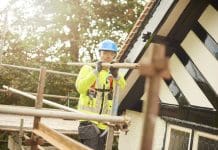Sarah Chilcott, Managing Director at Planning Portal, offers guidance on getting building control approval the first time
Most building work is subject to Building Regulations approval, and failure to comply can prove costly, both economically and as a drain on time better spent dedicated to completing your project. This essential guidance should help to get building control approval the first time.
1. Do your research
Research is a critical part of your project and investing time at this stage should make it go a lot more smoothly. Understanding the difference between building control and planning permission is vital, as is knowing your responsibilities. Whereas planning permission is about how a building looks, Building Regulations make sure your home is structurally and environmentally safe.
Fortunately, there is a wealth of guidance online to help you navigate the process, and if you’re in any doubt or need reassurance your local authority or Approved Inspector can help. Planning Portal developed our first interactive house in 2004 as a way of delivering often complex guidance on planning and Building Regulations to a wide variety of website users. It’s been through a number if iterations and, alongside the other interactive guides, remains one of our most popular pieces of content.
It’s important to remember that Building Regulations are subject to change so accessing the most current, authoritative content is vital. Approved Documents, for example, can be amended or updated. The most recent versions of the Approved Documents that support the technical “Parts” of the Building Regulations together with Regulation 7 – materials and workmanship are accessible using the link above.
2. Know your responsibilities
In general terms, if you are planning to carry out building work, as defined in Regulation 3 of the Building Regulations, then it must comply with the Building Regulations. This means that the regulations will probably apply if you want to:
- Put up a new building;
- Extend or alter an existing one;
- Provide services and/or fittings in a building such as washing and sanitary facilities, hot water cylinders, foul water and rainwater drainage, replacement windows, and fuel burning appliances of any type.
If you are employing a builder, it is important to be clear about whether they will be taking responsibility for compliance with Building Regulations and who will be liaising with the local authority or Approved Inspector. In some cases, if your builder is registered with a Competent Persons scheme, they may be able to certify some or all of the work they are undertaking.
Your Building Control Body (BCB) (either your local authority or Approved Inspector) can advise on the expected process for your project and will likely need to advise and inspect the site during various stages of the work. Don’t forget to ascertain whether you also need planning permission for your project before you start work.
3. Submit the right application
There are three main options available for building control applications; full plans, building notice and regularisation (a retrospective application relating to previously unauthorised works). The type of application will affect what supporting documents are required, expected timelines, costs and many other factors. Full plans applications for an extension or new building require a map detailing the proposed works, and it is important to ensure that the map you submit is compliant. A common reason for both building control and planning permission applications being rejected is failing to comply in this area. Save yourself time and money by choosing an accredited provider.
Remember to keep in touch with your BCB throughout the process who will monitor progress with regular inspections and help ensure you get your final certificate without a hitch.
In summary
Building control application processes are very different to applying for planning permission. Both local authorities and Approved Inspectors are keen to help clients make successful applications and will take the time to guide you through the process and avoid any pitfalls. Architects and structural engineers can also offer advice at planning and research stages.
Accessing sound, current guidance, submitting correct documentation and checking any issues should put you in good stead for a successful building control application.
Sarah Chilcott
Managing Director
Planning Portal
www.linkedin.com/company/planning-portal
www.facebook.com/Planning-Portal-173451576112703/













